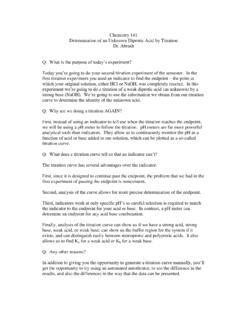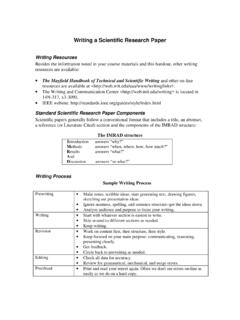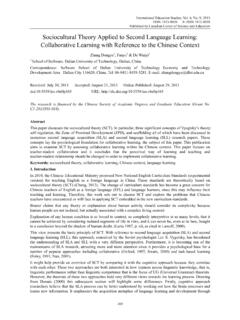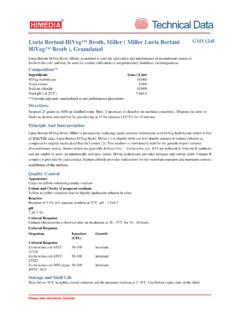Transcription of Chapter 1 Lecture Notes: The History and Scope of …
1 1 Chapter 1 Lecture Notes: The History and Scope of MicrobiologyI. What is microbiology?A. Microbiology is the study of organisms and agents that are generally too small to beseen clearly by the unaided eye. These organisms include viruses, bacteria, algae, fungi,and Microbiology can be applied or Microbiology is linked to many other scientific disciplines including biochemistry,cell biology, evolution, Subdisciplines (both applied and basic research)1. General microbiology: broad range of microbiological questions2. Medical microbiology: microbes that cause human disease3. Public health and epidemiology: Studies and controls transmission,frequency, and distribution of disease4. Immunology: the immune system5. Agricultural microbiology: impact of microbes on agriculture6. Microbial ecology: relationships between microbes and their habitats7. Food microbiology: Prevention of food borne disease; microbes that makefood and drink8.
2 Industrial microbiology: commercial use of microbes to produce products9. Biotechnology: manipulation of organisms to form useful productsII. What are microbes?MicroorganismsArcheaEubacteriaE ukaryaProtistaFungiTrue bacteria;prokaryoticProkaryotes that are verydifferent from truebacteria in terms of cellwall, membranes, RNAand protein synthesis;considered to be very oldevolutionarilyUnicellular;many nutrition types;includes protozoa,some algae, simplefungiUni and multicellular;absorptive nutrition;includes yeast,multicellular molds;mushrooms2 III. The Scope and relevance of microbesA. L. Pasteur "The role of the infinitely small in nature is infinitely large."B. 1st living organismsC. Live in every possible environmentD. More numerous than macroorganismsE. Constitute the largest component of biomassF. Fundamental to the ecosystemG. Have changed the course of History in obvious and not so obvious waysIV.
3 HistoryA. Discovering the "organisms"1. 1676: A. Leeuwenhoek first to observe and describe microbes accurately2. 1884: C. Chamberland constructed a bacterial filter that allowed theidentification of viruses3. 1898: Loeffler and Frosch identified filterable infectious agent as cause offoot-and-mouth disease in cattle4. 1898-1900: M. Beijerinck identified tobacco mosaic virus5. 1982: S. Prusiner described prions (infectious protein that causes aparticular normal protein to alter its shape and become a prion)B. Disproving spontaneous generation (that living organisms could develop fromnonliving matter)1. 1688: F. Redi first to challenge theory of spontaneous generation byshowing that if raw meat was protected from flies, the formation of maggots wasprevented2. 1748: R. Needham supported spontaneous generation of microbes byshowing that even after boiling mutton broth and pouring into sealed containers,growth of microbes occurred3.
4 1776: L. Spallanzani - challenged spontaneous generation as it pertained tomicrobes by showing that sealed containers that were boiled do not producemicrobes4. 1861: L. Pasteur rigorously disproved spontaneous generationa) filtered air showed that air contained microbial organismsb) constructed flasks with curved neck that allowed air into the flaskswhile dust, etc. remained in the neck placed broth into the flasks andboiled showed that no microbial growth resulted unless flasks weretipped to allow the broth into the neckC. The germ theory of disease1. Previously, people thought that disease was punishment for an individual'scrimes, due to poisonous vapors, and/or an imbalance of the "four humors".2. First proponents of the idea that invisible organisms caused disease wereLucretius ( ) and Fracastoro (1546)3. 1835: A. Bassi showed that silkworm disease was due to a 1867: J.
5 Lister showed that antiseptic surgical procedures reduced thefrequency of wound 1876/1884: R. Koch definitively proved that Bacillus anthracis caused thedisease anthrax in cows and Mycobacterium tuberculosis caused the diseasetuberculosis using Koch's ) The suspected pathogen should be present in ALL cases of the diseaseand NOT present in healthy ) The suspected pathogen should be grown in vitro in pure ) Cells from a pure culture of the putative pathogen should cause diseasein healthy ) The putative pathogen should be reisolated from the infected Preventing disease by vaccination1. E. Jenner inoculated people with cowpox to protect against 1885 Pasteur developed the rabies 1890: von Behring and Kitasato produced antibodies to purified toxins toprotect against diphtheria and 1884: E. Metchnikoff described phagocytosis of Discovering the effect of microbes on organic and inorganic matter1.
6 1856: Pasteur described lactic acid fermentation; contributions to 1887-1900: S. Winogradsky and M. Beijerinck studied soil microbes andtheir role in the biochemical cycles of sulfur, carbon, nitrogenV. Recent History of microbiology the 20th centuryA. Infectious diseases: The etiological agent of most infectious diseases has beenascertained. Current research focuses on understanding the molecular mechanisms bywhich disease is Chemotherapy: Discovery of antibiotics; antibiotic resistanceC. Immunology develops as a Physiology and biochemistry: Using microbes as a model, many physiological andbiochemical processes have been Genetics: Many of the advances in molecular genetics were made using bacteria asmodels. A few of the many:1. 1941: Beadle and Tatum 1 gene = 1 enzyme2. 1943: luria and Delbruck mutations are spontaneous in nature3. 1944: Avery, MacLeod, and McCarty DNA is the genetic material4.
7 1961: Jacob and Monod the operon and gene regulationF. Molecular biology: Many of the advances in molecular biology were made usingbacteria as models. A few of the many:1. 1970: Restriction enzymes discovered2. 1979: Insulin synthesized using recombinant techniques3. 1990: Gene therapy trials begin4. 1995: The nucleotide sequence of the first free-living organism (Haemophilusinfluenzea) publish












